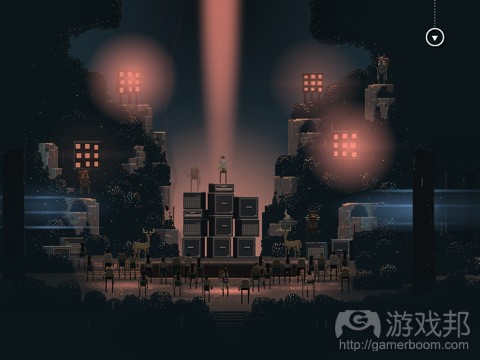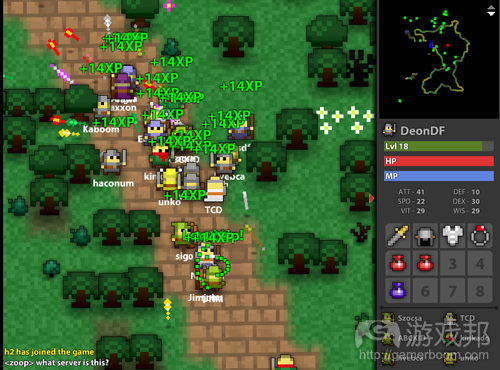总结开发者在GDC大会上讨论的5个重要议题
作者:Kris Graft
在GDC 2012大会召开这周时间里,开发者们分享知识、开展合作、达成交易和分享灵感,好友们甚至会促膝夜谈。GDC中显现出的哪些趋势会对从现在到GDC 2013这段时间内的行业产生影响呢?以下是我们从今年大会中总结出的一些趋势。
手机:满足特定用户的游戏需求
现在,已经面世的手机设备种类很多。在Android、iOS和Windows平台中,游戏开发者无法让自己的产品适合所有的手机游戏“玩家”。现在,手机游戏玩家的数量很多,开发者可以识别和精确定位适合他们的用户,从而取得商业上的成功。
来自《Superbrothers: Sword & Sworcery》开发商Capy的Nathan Vella指出:“乍看之下,锁定所有玩家的做法似乎很可取。像《水果忍者》、《愤怒的小鸟》和《割绳子》这样的超级主流游戏销量惊人。复制他人的成功,这是种很自然的想法。但事实上,如果你制作的是适合所有人的游戏,也就相当于没有锁定任何用户。想要打造市场巨作的想法会让你的游戏失去灵魂和新奇感。”
锁定特定用户的策略对Capy来说很奏效,《Superbrothers: Sword & Sworcery》在iOS发布前12个月便售出35万份。
Cave的Mikio Watanabe也给出了同样的建议。他公司旗下的硬核iOS卷轴射击游戏在开发时便清晰地瞄准特定用户群体,该游戏在App Store售出了12-13美元的高价。他说道:“如果是个硬核产品,就需要较高的价位,不要用低价贬低自己的产品。”
Matt Small的工作室Vector Unit从开发Xbox Live Arcade游戏《Hydro Thunder: Hurricane》转向手机游戏《Riptide GT》和《Shine Runner》,他强调道:“你想要制作的每种手机游戏都会有对应的用户群体……将用户当作产品开发的标杆……不要试图去开发满足所有人的游戏。”
“硬核”游戏更深入地探究免费模式
曾经,开发者或许认为“硬核玩家”将是最反对免费运营模式的群体。这是适合“休闲玩家”的东西,不是吗?最多只能适用于MMO游戏。但是今年来,非MMO“硬核”开发商也逐渐开始通过免费游戏模式来为硬核用户提供服务。
硬核游戏玩家能够接受免费游戏商业模式,只要它的设计是公平合理的。Valve的Joe Ludwig解释了其公司如何将《军团要塞2》从AAA盒装零售产品转变为免费、基于虚拟道具的在线产品。这种改变让《军团要塞2》重获新生。
Ludwig说道:“这种做法极具风险性,有可能使整款游戏毁于一旦,但是我们觉得,这种尝试新商业模式的风险值得一试。”
Gamasutra还采访了A.C.R.O.N.Y.M.(游戏邦注:Unity网页游戏《Mechwarrior Tactics》开发商),该公司旗下基于《Mechwarrior》系列游戏的策略游戏(游戏邦注:这是典型的硬核游戏题材)《Mechwarrior Tactics也将采用免费模式。
Ironclad Games在GDC上展示了新游戏《Sins of a Dark Age》,开发商将RTS元素同《英雄联盟》式的动作RTS游戏玩法结合起来,营造出独特的游戏体验。这款游戏同样也将采用免费模式。在同一个展台上的还有Crytek的免费射击游戏《Warface》。这不是一种全新的趋势(游戏邦注:之前发布的《战地:英雄》和《英雄联盟》已经采用了免费模式),但GDC 2012显示,即便是硬核游戏开发商都已经开始考虑采用这种商业模式。
以新视角看待玩家反馈
关注小组、可用性测试和游戏测试在游戏行业中已经不是什么新鲜事,但游戏开发商处理玩家反馈的方法正在发生改变。比如,Insomniac旗下《抵抗3》首席设计师Drew Murray解释称,团队重新开始设计游戏中瞄准和射击的控制方式,尽管该系列之前已经发布过两款游戏。整个团队都根据玩家的反馈来重新构建这些控制方式。
但是即便如此,有些开发商还是以相当传统的方式处理玩家反馈。Spry Fox同Wild Shadow Studios合作开发了网络游戏《Realm of the Mad God》,负责人David Edery说道,在发现某些玩家的无意识行为后,团队决定“解决”这个问题,对游戏做出重大的修改,尽管他们知道这些修改可能会引起某些社区成员的批评。
开发商做出了修改,惹恼了某些人,但是却看到游戏的留存率飞速攀升。Edery说道:“作为一家公司,我觉得我们很擅长于通过测试来验证修改效果。经验就是,要不断告诉自己,错误并不可怕,我们只需要改正即可。”
Vector Unit的Matt Small提醒手机游戏开发商,他们不可过于“珍藏”自己的游戏,即便游戏还处在开发初期。向他人展现你的游戏,获得他们的反馈,必要的话可以根据反馈采取行动。由于手机设备携带的便利性,所以让其他人体验你的游戏是件很容易的事情。他说道:“将游戏展示给好友和家人,这很重要,你也可以到大街上寻找愿意尝试你的游戏的陌生人,让他们提出反馈意见。”
主机的未来何去何从
视频游戏主机未来在行业中的情况仍不清晰。它肯定会在行业中占有一席之地,但所有人都在猜测它的市场份额以及它们将如何为市场提供服务。在GDC上,许多开发商分享了他们的看法。
Ben Cousins之前就职于EA旗下《战地》开发商DICE,目前在手机游戏公司Ngmoco工作。在GDC上,他表示游戏主机的消亡已经开始显现。他说道:“我所说的‘消亡’,指的是它的市场份额日益缩小而且没有反弹的迹象。”
他说道:“我相信,手机设备和手机平台将成为攫取西方主机市场的力量。”
但是,仍然有开发商相信,下一代的主机能够获得胜利。Gamasutra在大会上采访的众多开发商都表达了他们对下一代主机的期望。
当然,有些开发商认为,它们需要有更强大的处理能力、更多的RAM和更容易的跨平台开发技术。但有些开发商认为,主机制造商应当借鉴手机市场的做法,放宽限制。
有些开发商表示,他们希望下一代主机具有更大的平台开放性,这种开发性使在线游戏可以更快速地更新、在线社区能够形成更直接的关系同时更支持新的商业模式。或许,不久后我们会看到实现上述目标的新主机面世。
游戏设计与人类思维的关系
玩家是否会将自己想象成Nathan Drake(游戏邦注:《神秘海域2》中的角色)?如果游戏不能保持对玩家的刺激,是否就有可能失败?游戏如何同玩家的大脑互动?参加GDC 2012的游戏设计师仍然在继续讨论玩家玩游戏的基本方式。
来自《神秘海域》开发商Naughty Dog的Rich Lemarchand不喜欢“沉浸度”和“参与度”这样的词。他认为,这种描述是毫无意义的。反之,游戏开发商应当更加关注如何“捕捉关注”和“保持关注”。这可以通过美学、叙述、故事和游戏玩法系统来实现。
Naughty Dog程序员Kaitlyn Burnell在她自己的GDC演讲中表示,因为大脑的运转依赖于化学反应,所以玩家某种情感的维持只能维持有限的时间。她说道:“如果大脑过分地使用那些化学物质,那么玩家就不再能够感受到某种情感。”
育碧的Jason VandenBerghe也考虑过游戏与大脑间的关系。在GDC上,他讨论了心理学中人类行为的5种刺激(游戏邦注:即开放性、严谨性、外向性、亲和性和神经质)及其在游戏制作中的运用。他说道:“玩游戏和生活的理由是相同的。”
Dan Pinchbeck辩解称,过分地刺激玩家大脑会影响到游戏气氛。他所制作的游戏事实上并不存在游戏玩法系统,但通过视觉和故事讲述却能够给人们带来很强烈的刺激。他说道:“缺乏刺激并不等于缺乏体验。事实上,缺乏刺激使得其他体验能够获得成长。”
Thatgamecompany的Chris Bell不仅讨论了玩家如何看待游戏,而且还阐述了玩家在同其他玩家一起玩游戏时如何看待游戏。他的工作室开发了游戏《Journey》,游戏中没有对话、文字,玩家也不能看到其他玩家,该产品便是通过这种方式来构建玩家关系。它是最纯粹的在线游戏,而且颇受赞誉。Bell说道:“因为你同其他玩家一起参与到这些体验中,因而同样可以体验到各种情感。”(本文为游戏邦/gamerboom.com编译,拒绝任何不保留版权的转载,如需转载请联系:游戏邦)
From the Editor: 5 key takeaways from GDC 2012
Kris Graft
If you work in the video game industry and happen to be even more exhausted than usual for a Monday morning, you might have been at last week’s Game Developers Conference 2012.
It was a week of knowledge-sharing, networking, deal-making and inspiration-giving, possibly punctuated nightly by a few drinks with friends. But when the honeymoon post-GDC high is over in a week or two, what are the trends that emerged at GDC that will leave an impact between now and GDC 2013? Here are a few trends that we identified from this year (see all of Gamasutra’s extensive coverage here).
Mobile: For all your niche game needs
There are a lot of mobile devices out there right now. Between Android platforms, iOS and Windows, game developers do not need to try to be everything to every mobile “gamer.” Now there is big enough of a pool of mobile players that developers can identify their audience, target them specifically, and become commercially successful.
Nathan Vella from Superbrothers: Sword & Sworcery developer Capy told GDC attendees, “At first glance, the logic [of targeting everyone] makes sense. Super mainstream games such as Fruit Ninja, Angry Birds, and Cut the Rope have each sold tens of millions of copies. Attempting to replicate that success is natural. But in reality, if you are making a game for everyone, you are actually making a game for no-one. The hit-based mentality takes you away from making a game that has soul or is fresh.”
The strategy of targeting a specific audience worked out for Capy, with the stylized Superbrothers: S&S selling 350,000 units in its first 12 months on iOS.
Similar tips came from Cave’s Mikio Watanabe. His company’s hardcore iOS scrolling shooter games — targeted for a clear audience in mind — sell for about $12-13 on the App Store. “If it’s a hardcore product, go for the higher price point,” he said. “…Don’t underprice your product.”
And Matt Small, whose studio Vector Unit went from Xbox Live Arcade game Hydro Thunder: Hurricane to mobile games Riptide GT and Shine Runner, stressed, “There’s an audience for just about any kind of game you want to make on mobile. …Use the [audience] as a benchmark…don’t try to be all things to all people.”
“Hardcore” developers dive deeper into free-to-play
At one time, developers might have believed that “hardcore gamers” would be some of the first to reject the free-to-play business model. That’s a “casual gamer” thing, right? At best, it’s for MMOs? But in recent years, the eyes of “core,” non-MMO developers have opened up to the possibility of serving a core audience through the free-to-play model.
Core game players are open to the free-to-play business model, as long as it’s done in a way that doesn’t appear unfair or exploitative. Valve’s Joe Ludwig explained how his company changed Team Fortress 2 from a triple-A boxed retail product to a free-to-play, virtual item-based online product. The change revived Team Fortress 2′s financial viability in a big way.
“It was risky, everything could have gone horribly wrong, but we felt it was worth the risk to try the new business model,” Ludwig said.
Gamasutra also spoke with A.C.R.O.N.Y.M., one of the developers behind the Unity-based browser game Mechwarrior Tactics. It’s a tactics game (typically a rather hardcore genre) based on the Mechwarrior franchise (giant customizable robots — not really for mom), and it’s going to be free-to-play.
Same goes for Ironclad Games’ stellar-looking Sins of a Dark Age, a game shown at GDC which combines RTS elements with League of Legends-style action-RTS gameplay to create something unique. Also on the showfloor was Crytek’s free-to-play shooter Warface. It’s not a completely new trend (see Battlefield Heroes and LoL), but GDC 2012 showed that even more core game developers are going to give the business model a serious shot in the near future.
Re-think player feedback
Focus groups, usability testing and playtesting are nothing new, but the way that game developers approach feedback on their games is changing. Drew Murray, lead designer of Resistance 3 at Insomniac, for example, explained how the team started the game’s aiming and shooting control from scratch, despite having released two previous games in the franchise. The team then relied heavily on player feedback to rebuild those controls.
But even that’s a rather traditional approach towards player feedback. Spry Fox’s David Edery, whose studio worked with Wild Shadow Studios on the online game Realm of the Mad God, said that after noticing some unintended player behavior, the developers decided to “fix” the issue and make significant changes to the game, even though they knew the changes would incite criticism from some of the more vocal community members.
The developers made the change, pissed off some people, then saw retention rates soar. “As a company, I feel like we’ve gotten really good at saying ‘screw it, let’s change it and see what happens.’ That’s kind of the takeaway — remember to tell yourself, it’s okay if it doesn’t work, we’ll just change it back,” said Edery.
Vector Unit’s Matt Small reminded mobile game developers that they shouldn’t be “precious” with their games, even when they’re early in development. Get your games in front of people, get their feedback, and, if it warrants action, act on that feedback. With the portability of mobile devices, putting your game in someone’s hands is as easy as ever. “It’s really important to get it in front of friends and family, you want to pull people off the street [to try your game and give feedback],” he said.
Console is a question mark
The role of video game consoles in the future is unclear. There will surely be a role, but the size of the addressable market and how they serve that market is anyone’s guess. At GDC, many developers offered their own speculation.
Ben Cousins, formerly of Electronic Arts and Battlefield developers DICE, now works at mobile game firm Ngmoco. At GDC, he said the death of game consoles is already underway. ” By ‘die’, I mean … something that has significantly smaller market share with no sign of return,” he said.
“I believe that mobile devices and mobile platforms are the disruptive technologies that are going to cut a slice through the Western [console] market,” he said.
But there are still developers who are counting on the next-gen of consoles to succeed. Developers polled by Gamasutra, varying widely in size and influence, gave us a few items for their next-gen console wishlists.
Of course, some of them said they wanted more processing power, more RAM, and easier cross-platform development. But other wishes — which were less likely to have come up back in 2005 — related to developers suggesting console manufacturers should take cues from the mobile marketplaces, with their smaller-sized apps and a level of curation that isn’t as strict as marketplaces from Microsoft, Sony and Nintendo today.
Others told Gamasutra that more platform openness would be welcome in the next-gen, the kind of openness that would allow for faster updates for online games, a more direct relationship with online communities, and more support for new business models. We wouldn’t be surprised to see a new console come along and try to be all of these things.
Game design and the brain still an important discussion
Do players put themselves in the shoes of Nathan Drake? If a game doesn’t always stimulate the player’s twitch reflex, does it fail? How do games interact with players’ brains? Game designers at GDC 2012 continued to ponder the important and fundamental ways in which players play games.
Rich Lemarchand from Uncharted developer Naughty Dog dislikes words like “immersion” and “engagement.” They’re rather meaningless, he said. Instead, game developers should be more concerned with “getting attention” or “holding attention” of players. That can be done through aesthetics, narrative and story, or, most effectively, through gameplay systems. When well-designed, “gameplay is like mental catnip to us,” he said.
Fellow Naughty Dog staffer, programmer Kaitlyn Burnell, said in her own GDC session that since the brain relies on chemical reactions, players can only sustain certain emotions for a limited amount of time. “If the brain uses those chemicals too much, players won’t be able to feel that emotion,” she said.
Ubisoft’s Jason VandenBerghe has also been thinking about games and the brain. At GDC, he talked about psychology’s five motivations for human behavior — openness, conscientiousness, extroversion, agreeableness, and neuroticism — and applied that to making games. “We tend to play for the same reasons we live,” he said.
Dan Pinchbeck with Dear Esther developer thechineseroom argued that over-stimulation of players’ brains actually kills atmosphere. His game is virtually void of gameplay systems, but it under-stimulates to great effect, telling a story through visuals and narrative along the way. “A lack of stimulation does not equate to a lack of experience. In fact, a lack of stimulation allows for other experiences to grow,” he said.
Thatgamecompany’s Chris Bell talked about not only how players think about games, but how players think about games when playing them with other players. His studio is behind the game Journey, which facilitates relationships through online play with no speech, text, or ability to see other players’ faces. It’s an online game in the purest sense, and it achieved that to critical acclaim. “Because you engage in these experiences with another player, there’s the potential to go through a wide range of emotions with them,” said Bell. (Source: Gamasutra)









































 闽公网安备35020302001549号
闽公网安备35020302001549号